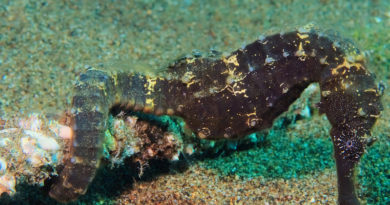Underwater Photographers: You Might Have Chromostereopsis
We have to talk about Chromostereopsis: You might have it, but you might not even know it. What is Chromostereopsis? It’s an effect where the wavelength of light is interpreted by your visual system as the depth of the part of the image. Red parts tend to stick out, blue parts tend to look set back.
Check out this image I took of a tunicate, drifting along Pescador island in the Philippines. It looks oddly 3-dimensional, while obviously nothing happened to your screen to allow it to project 3-dimensional images. It’s all in your retina and your brain which is happening here.
Often you have to look at the image under the right conditions, with a screen that’s large enough relative to your field of view, with sufficient contrast, and at the right distance to your eyes. Mostly the illusion works.
Here is another example: A cool nudibranch with red dots on a blue background. The dots give the animal a spooky 3d-effect. Chromostereopsis again:
Wikipedia explains it like this: “Chromostereopsis is a visual illusion whereby the impression of depth is conveyed in two-dimensional color images, usually of red–blue or red–green colors..”. Also, very interestingly: “The effect can appear much more pronounced when suitable images are viewed while wearing eyeglasses needed to correct myopia, with the effect almost completely disappearing when the glasses are removed.”
The fact that Chromostereopsis sounds a bit like a disease is semi-funny and hopefully got some of you to read this article. That’s a strategy I like to use, pull folks in with shallow humor, and then teach them some science.
I think the effect is under-used. Chromostereopsis is, to my knowledge, rarely used on purpose in photographic composition. There’s a rare chance to do something really new in underwater photography, in my opinion.
Many thanks to Pauline Wong for the nudibranch image showing the effect, and to Alex Holcombe, psychophysicist extraordinaire, who told me about the effect a few years ago, and reminded me of its name today.
Best Fishes,
Klaus

